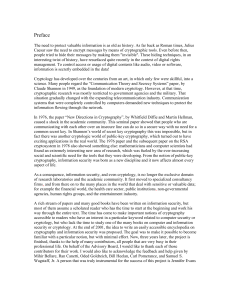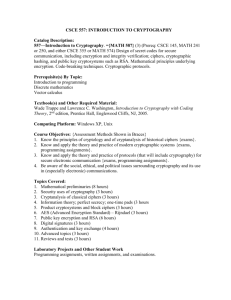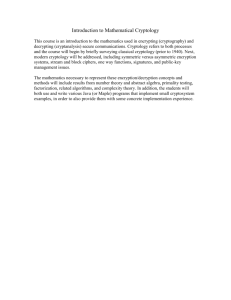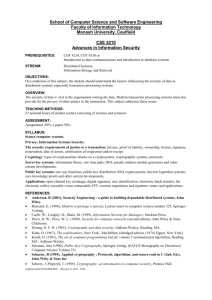Prof Alko Meijer - Standardization in Cryptology
advertisement
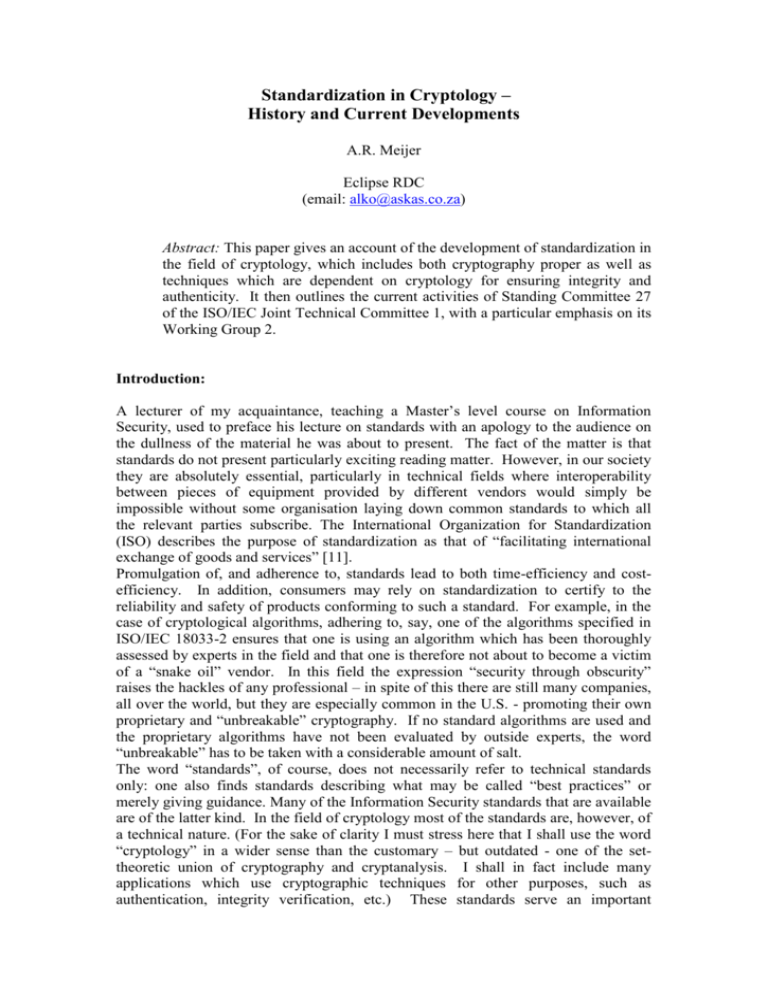
Standardization in Cryptology – History and Current Developments A.R. Meijer Eclipse RDC (email: alko@askas.co.za) Abstract: This paper gives an account of the development of standardization in the field of cryptology, which includes both cryptography proper as well as techniques which are dependent on cryptology for ensuring integrity and authenticity. It then outlines the current activities of Standing Committee 27 of the ISO/IEC Joint Technical Committee 1, with a particular emphasis on its Working Group 2. Introduction: A lecturer of my acquaintance, teaching a Master’s level course on Information Security, used to preface his lecture on standards with an apology to the audience on the dullness of the material he was about to present. The fact of the matter is that standards do not present particularly exciting reading matter. However, in our society they are absolutely essential, particularly in technical fields where interoperability between pieces of equipment provided by different vendors would simply be impossible without some organisation laying down common standards to which all the relevant parties subscribe. The International Organization for Standardization (ISO) describes the purpose of standardization as that of “facilitating international exchange of goods and services” [11]. Promulgation of, and adherence to, standards lead to both time-efficiency and costefficiency. In addition, consumers may rely on standardization to certify to the reliability and safety of products conforming to such a standard. For example, in the case of cryptological algorithms, adhering to, say, one of the algorithms specified in ISO/IEC 18033-2 ensures that one is using an algorithm which has been thoroughly assessed by experts in the field and that one is therefore not about to become a victim of a “snake oil” vendor. In this field the expression “security through obscurity” raises the hackles of any professional – in spite of this there are still many companies, all over the world, but they are especially common in the U.S. - promoting their own proprietary and “unbreakable” cryptography. If no standard algorithms are used and the proprietary algorithms have not been evaluated by outside experts, the word “unbreakable” has to be taken with a considerable amount of salt. The word “standards”, of course, does not necessarily refer to technical standards only: one also finds standards describing what may be called “best practices” or merely giving guidance. Many of the Information Security standards that are available are of the latter kind. In the field of cryptology most of the standards are, however, of a technical nature. (For the sake of clarity I must stress here that I shall use the word “cryptology” in a wider sense than the customary – but outdated - one of the settheoretic union of cryptography and cryptanalysis. I shall in fact include many applications which use cryptographic techniques for other purposes, such as authentication, integrity verification, etc.) These standards serve an important purpose, apart from (e.g.) promoting/enabling interoperability: it is well known that in cryptology there are usually many more ways of doing things incorrectly, in the sense of reducing security, than there are of doing things right. In fact, in cryptology it is quite possible that two rights make a wrong, as shown for example by the cryptanalysis of the Akelarre cipher [2] [6]. A review by experts, such as takes place in the standardization process, gives a high degree of confidence that the implementation decreed by the standard is the correct one. An early history It must be noted that cryptology (and cryptography in particular) are in a somewhat unusual position when it comes to standardization, at least when viewed from a historical perspective. Until the mid-1970s cryptography was the preserve of the military, the intelligence services and the diplomats, and, in an attempt to ensure greater security of their communications, the algorithms used were restricted to country-specific, or usually to even narrower, domains. Thus there were some six or eight different and mutually incompatible types of Enigma machines (i.e. variations of the Enigma algorithm) in use by the German authorities during World War 2. As Maurer puts it in [7]: “Until after the second world war, cryptography can be seen as more of an art than a science, and concerned almost entirely with encryption.” Apart from Shannon’s paper [10], published (after being declassified in error, according to some) in 1949, little about the subject appeared in the open literature, and consequently there was no possibility of, nor presumably any need for, standardization. In fact, the whole concept of standardization in cryptography would have appeared to be an oxymoron. In the 1970s, however, two major developments took place. The first of these was the invention of public-key cryptography by Diffie and Hellman [5] and its subsequent implementation as the RSA system by Rivest, Shamir and Adleman [9], which was patented in the United States but not elsewhere. The RSA algorithm quickly became something approaching a de facto international standard for asymmetric (i.e. public key) cryptography.. The second of these developments was the increased need in the late 1960s for secure data communication in the private sector, at that time particularly in the banking industry. This led to a call by the U.S. National Bureau of Standards for a proposal for a standardized secure encryption algorithm. After some hiccups, described in the next section, this led in due course to the adoption of the Data Encryption Algorithm as a standard (DEA - for sensitive but unclassified information) for the U.S. Federal Government as the Data Encryption Standard (DES) of FIPS 46, 1975. By extension, and because of the clout of the U.S. Federal government as a purchaser of communication equipment, the DES in its turn became a de facto standard for symmetric (secret key) cryptography. DES, and its more secure two- or three-key version Triple-DES is still in wide use, among others as a banking standard for electronic funds transfers and in civilian satellite communications. The need for standards in cryptology has, in the last decade and a half, become even more pronounced with the development of the Internet, and consequently of electronic commerce, both consumer to business (C2B) and business to business (B2B). In these environments, protecting the integrity and guaranteeing the origin of electronic documents become key issues in ensuring that a system can work properly. This is apart from the “traditional” purpose of cryptography, namely the protection of the confidentiality of trade secrets, intellectual property, etc. The DES selection Process To show how times have changed, it may be interesting to consider the differences between the methods by which the Data Encryption Standard on the one hand and its intended successor, the Advanced Encryption Standard (AES), on the other, were established. The first step towards the DES was the publication in the U.S. Federal Register of May 15, 1973 of a solicitation from the National Bureau of Standards (NBS) for encryption algorithms for computer data protection. The fact that an open call was issued was, by itself, already a tremendous change from the secrecy previously surrounding anything to do with cryptography. It was, as noted, an admission that cryptography was going to be needed more and more in the “civilian” sector for protecting electronic information between computers and terminals, and between computers. The responses to this request indicated that there was a great deal of interest, but little actual knowledge about the subject in the open community, and no algorithm was submitted. The only exception to this state of ignorance in the private sector appears to have been at IBM, which had been conducting research in the field since the late 1960s. In response to a requirement from the British banking industry, it had produced an algorithm called LUCIFER, designed by Horst Feistel. In the absence of a useful response to its first call the NBS issued a second solicitation, and IBM was specifically requested to make a submission. IBM proposed a cipher based on LUCIFER, and this, eventually became the DES, as FIPS 46, 15 January 1977. However, there were a couple of intermediate steps which were shrouded in some mystery, and which continued to dog the DES for a long time, with, curiously, mainly positive consequences for cryptology as a whole. Since the NBS had no particular expertise in the field of cryptographic algorithms it asked the National Security Agency (NSA) – then even more secretive than it is today - to assist in the evaluation of the IBM proposal and a couple of changes were made to the original design. Firstly, the key length, which IBM was rumoured to have proposed as 128 bits, appeared in the standard at only 56 bits, thereby greatly weakening the algorithm by opening up the possibility of brute force attacks. Whether the NSA had, in 1975, the capability of successfully carrying out such an attack seems doubtful. One may be fairly certain, however, that the NSA had such a capability long before an exhaustive search attack was successfully carried out in the open community by the Electronic Freedom Foundation in 1999. The EFF used custom-built equipment which by then cost a mere $250 000. When DES was launched an estimate for the cost of a successful DES-cracker had been put at about $20 million. Secondly, the substitution boxes proposed by IBM were replaced by others designed by the NSA. This created a suspicion that the NSA might somehow have introduced a “trapdoor” into the algorithm – this suspicion being aggravated by the fact that the design principles were never, up to the present day, made public. DES has been under intense scrutiny by the cryptographic community ever since its introduction – in fact it is my belief that it was a major factor in making cryptology an acceptable academic discipline – but no such trapdoor was ever found, and it most probably does not exist. The AES Selection Process By contrast, the creation of the Advanced Encryption Standard, was a model of openness. A formal call for algorithms was issued by the (U.S.) National Institute for Standards and Technology (NIST), successor to the NBS, on 12 September 1997. About a year later NIST announced fifteen candidates – from twelve different countries - and, making all the relevant information publicly available, solicited comments from the public, i.e. from the international cryptological community. At a second conference in March 1999 NIST announced the five finalists, with complete motivations for the exclusion of the other ten, and a second round of public comment and review was started. All the public input was (and still is [1]) readily accessible to anyone interested and NIST’s own team evaluated and reviewed this, while also conducting its own research. In October 2000 NIST announced its choice of Rijndael, submitted by two Belgian cryptologists, as its preference for the AES, and this became the Federal standard (FIPS 197) in November 2001. The open process by which this came about, shows how cryptography has moved into the mainstream of information security, away from the secrecy with which it was previously associated. The reason for this sea change lies in the extensive use that is made of it in modern information handling, which also points to the necessity of standardization in the field. Even so, the road towards international standardization has not been an entirely smooth one. International Standardization – The Early Years: The material in this section is mainly taken from [11]. The first international cryptology standards were published by ISO’s Technical Committee TC 68, “Banking, securities and other financial services”, in the mid1980s. They were based on DES and its modes of operation as laid down by the NBS and were similar to those adopted by the American Standards Institute (ANSI). Earlier a Working Party WP1 on Data Encryption of Technical Committee TC97 (Information Processing) had been established, which was in 1984 transformed into SC20 (Data Cryptographic Techniques). This committee, however, only managed to produce two standards before the U.S. in 1986 proposed a change in its scope so as to exclude encryption algorithms. The U.S. at that time, and later, was extremely concerned about the proliferation of encryption technology, and controlled the export of such technology in the same way as munitions. Thus, for example, the Digital Signature Algorithm was suitable for export from the U.S. because NIST deliberately selected a design which, unlike RSA, could not be used for encryption purposes. (Export restrictions were only modified - eased, but not lifted - in 2001.) TC97 recognised “that the standardisation of encryption algorithms was a politically sensitive area of activity in several countries” [11] and this in due course, with the approval of the ISO council, led to the abandonment of all efforts in this direction. To recall the atmosphere of those times, we may mention that in the early 90s, the United States saw the hullabaloo about the Clipper chip. In retrospect this whole episode shows the characteristics of farce, but at the time it was an extremely contentious issue. The Clinton administration in 1993 proposed a Federal Information Processing Standard (FIPS) for an “Escrowed Encryption Standard”. The encryption would take place using a (secret!) algorithm called Skipjack, implemented on a chip which used a master key (unique to the chip), possession of which would enable one to decrypt all data encrypted using that chip. This master key would be split, half of it being kept by each of two U.S. Federal agencies. Whitfied Diffie (him of the DiffieHellman key exchange protocol) put it bluntly in testimony to a committee of the United States Congress: “They want to provide a high level of security to their friends, while being sure that the equipment cannot be used to prevent them from spying on their enemies.” [4] In actual fact, the Clipper chip was never a success: AT&T manufactured a few thousand secure telephones for government use, in an unsuccessful attempt to seed the market, but neither key escrow, nor its less aggressively named successor “key recovery” were ever successful commercially. SC27, which succeeded SC20, remained subject to the requirement of not doing anything cryptological, but in 1996 asked its parent body, JTC1 – a joint committee of ISO and the International Electrotechnical Commission , and up to now the only one – to lift the restriction. JTC1, after a ballot of its national member bodies, agreed to this proposal. (It may be relevant to point out that voting on JTC1, as on ISO and its subcommittees, takes the form of “one country - one vote”.) As of now, cryptology forms a major part of the standardization efforts of SC27. JTC1 and SC27 JTC1 is, as noted, a joint technical committee of the International Organization for Standardization and the International Electrotechnical Commission, with information technology as its brief. Countries are represented on ISO by their national bodies. Standards South Africa (STANSA), a division of the S.A. Bureau of Standards, is the body representing South Africa. ISO was established in 1946 with South Africa as one of its founder members. SC27 is a subcommittee of JTC1, its name being “Security Techniques”. Its area of work includes identification of generic requirements for IT security and the development of security techniques and mechanisms, as well as the development of security guidelines and management support standards and other documentation. At STANSA its work is mirrored in the activities of STANSA Standing Committee 71F on which local commerce and industry are represented. This committee considers South African requirements for standardization in IT security techniques and recommends, inter alia, on the adoption of ISO standards as South African national standards. The activities of SC27 are divided among three working groups. With Prof. Walter Fumy from Germany as overall chairman of SC27, the working groups are Working Group 1, under Ted Humphreys (U.K.) as convener, dealing with requirements, security services and guidelines; Working Group 2, until very recently under Marijke de Soete (Belgium) as convener, dealing with security techniques and mechanisms. This group deals with all the cryptological algorithms and protocols, as will be described in more detail below. Working Group 3, with Mats Ohlin (Sweden) as convener, on security evaluation criteria. STANSA’s 71F as a whole considers all the activities of SC27. In view of the specialized expertise required in considering the activities of SC 27’s Working Group 2, a separate working group of STANSA’s SC27 was established a few years ago to provide input into SC 71F on all matters cryptological. Working Group 2 The original SC20 had two working groups dealing with cryptography: one for symmetric algorithms, and one for asymmetric ones. WG2 of SC27 fortunately merged these two activities. In its terms of reference WG2 is described as providing “a center of expertise for the standardization of IT security techniques and mechanisms.” While this sounds like a bit of self-aggrandizement, one is impressed with the stature of those taking part in its deliberations: it would probably be invidious to name any specific examples. At the risk of getting personal: I have had great pleasure and derived immense benefits from attending a few of their meetings. The scope of its activities covers techniques which include confidentiality entity authentication non-repudiation key management data integrity (e.g. MACs, hash-functions and digital signatures). The scope of WG2, as published, explicitly mentions that the techniques include both “cryptographic and non-cryptographic” ones, which sounds rather tautologous. However, currently only cryptographic techniques are under consideration. The long way towards a standard From the original idea for a standard (or a technical report) to the final product the process goes through six stages, taking a minimum of some three years, and usually quite a bit more. The stages are: A Study Period during which the relevant committee or working group informally studies a field in which standardization may be required or desirable. At the end of this period a document is produced which either recommends dropping the subject or submitting it to a ballot to determine whether it should progress to the next stage. New Work Item Proposal. The JTC1 Secretariat, on input from a committee or from one of its national body members, conducts a ballot on whether a new standard should be created. If the vote is positive, the relevant standing committee, or a working group of that committee, proceeds to the next stage. Working Draft. Requests for input into the process are issued, an editor is appointed and a working draft is produced. This is circulated to the membership of national bodies. Comments from the member bodies are invited and discussed at the meetings of the Standing Committee and eventually (the working draft may go through several iterations) the working draft is upgraded to the level of Committee Draft. Committee Draft. This is circulated to the member bodies of the Standing Committee for a three month letter ballot. Comments, both technical and editorial, are discussed and points of disagreement are settled, preferably by consensus, although this does not always turn out to be possible. Again, the committee draft may go through several versions. Draft International Standard: When no more technical changes appear to be required, the document is circulated to the members of ISO (and in the case of JTC1, of IEC) for a ballot. If the draft international standard receives the necessary support, it is then finally published as an International Standard. International Standard: Member countries can adopt ISO International Standards, with or without modification to suit local conditions, as their national standards. Several of the products of ISO’s SC27 have, on the recommendation of STANSA’s SC71F, been adopted as South African National Standards. These are then available – at a more reasonable price! – from the SABS, instead of from ISO. It may be noted that, in the South African context, ISO standards have little, if any, legal status: where local legislation or regulation mandates the adherence to some standard, preference is given to a South African national standard. International standards issued by JTC1 are subject to review every five years. At such a point it may be re-confirmed for another five year period, revised (in which case the sequence Working Draft, Committee Draft, Draft International Standard, International Standard is repeated) or it may be withdrawn. A recent case of withdrawal is that of ISO/IEC 8372: Modes of Operation of a 64-bit block cipher algorithm – 64-bit block ciphers are nowadays regarded as “legacy systems” their block length being inadequate for modern use. Another example of an imminent withdrawal (probably) is ISO/IEC ISO 9979: Registration of cryptographic algorithms. This dates from the bad old days referred to earlier: while SC20 was prohibited from active research in cryptographic standards, it was felt that some means of reference to cryptographic algorithms was desirable. The result was the compromise of maintaining a register of such algorithms; any one was permitted to apply for registration without any evaluation of the algorithm, in fact even without divulging any information about it – a classic example of “security through obscurity”! Many, if not most, of us feel that this register serves no purpose any more, if it ever did, since its effects may well be harmful. Recent Activities of WG2 of SC27 The most recent standards published by ISO in the compilation of which the Working Group was involved include Digital signatures giving message recovery , Part 2: Integer factorization based mechanisms; Cryptographic techniques based on elliptic curves, Parts 1, 2 and 3: General, Digital signatures and Key establishment. At the present moment the following are under discussion Hash functions Non-Repudiation Digital signatures with message recovery (using elliptic curves) Random bit generation Prime number generation In addition, WG2 collaborates with Technical Committee 68 on standards in the banking, investments and other financial services. Similarly, SC17, which deals with smart card technology, has a close relationship with SC27, depending on it for the standardization of security techniques. WG2 collaborates with WG3 on a proposed standard on Security Requirements for Cryptographic Modules. There is an old joke common in the engineering profession: “The beauty of standards is that there are so many to choose from.” This is also true to some extent when it comes to cryptographic standards: at least three other bodies have in recent years been looking at these: Firstly, the European Union’s project, now concluded, on New European Schemes for Signature, Integrity and Encryption (NESSIE) which evaluated a number of protocols and algorithms; Secondly, the Japanese Information Technology Promotion Agency’s CRYPTREC (Cryptography Research and Evaluation Committees) which continues to evaluate algorithms; and Finally, the Institute of Electrical and Electronic Engineers (IEEE) which has published its P1363 and P1363a standards, concentrating on public key cryptography. Earlier, from 1988 to 1992 there was the European Community’s RIPE project [2], which, however, in the then prevailing political climate, was expressly excluded from considering encryption algorithms, but produced some worthwhile algorithms for hash functions and similar non-sensitive applications. Fortunately, relations between SC27 and these other organisations are very good, and they regularly provide inputs into the deliberations of SC27’s WG2. In fact, the processes operate in both directions. For example, NIST has adopted the ISO standard 9798-3 as the federal standard FIPS 195, and large parts of an ANSI standard on random bit generation are likely to be included in the coming ISO/IEC standard. Conclusion Most of the workers on SC27 (and, no doubt on the other standing and technical committees, with which I am unfamiliar) are volunteers, though some of them are supported by their employing bodies, which recognise the benefits that accrue from participation in the standardization processes. The work can be quite demanding at times (especially when one of SC27’s six monthly meetings is due). It is, however, tremendously satisfying. One is aware of being among leaders in their fields, while at the same time having the pleasure of watching an important document develop, and in this sense being ahead of the rest of the world. Thus one of the many spin-offs of taking part in the standards setting process is the insight into techniques which one may describe as new but not immature. If I may cite just one example close to my heart, it would be ISO/IEC 18033 on encryption techniques themselves, where the Working Group went to great trouble to select a small set of undoubtedly strong and efficient algorithms, drawing on the results of NESSIE and CRYPTREC, mentioned earlier, in the process. I would like to end with two calls: Firstly to anyone able to contribute to the work of STANSA’s Working Group 2 of SC71F to consider joining it, in the hope that WG2 may then benefit from his or her expertise. The second was one of the main reasons for writing this paper. I suspect that even among an audience like the one addressed here, there may be a fair degree of ignorance about the existence of South African standards relating to cryptology. I am hoping that this paper will contribute a little to removing that ignorance. Most of the ISO/IEC standards from SC27 are accepted as South African national standards and using them in your products or working environment gives a high degree of credibility to your organisation. In the cryptological field, an unknown or proprietary technique is viewed not just with disdain but with distinct suspicion. The standards are readily available from the South African Bureau of Standards. Let me finally add a paranoid comment: when acquiring a security related product, it is not sufficient to accept the vendor’s word that the cryptography implemented in that product satisfies a particular standard. Ideally, one should either have complete trust in the vendor, or ensure (either by oneself or through a trusted third party) that the implementation does what it is supposed to do in terms of the standard and nothing more. It is only too easy for a malicious party to implement the cryptography correctly but nevertheless leave an open backdoor. To name only one example, cryptographic keys with deliberately low entropy may be generated for the AES, while using the AES itself correctly. References 1. AES website: www.nist.gov/aes/ 2. Alvarez, G., de la Guia, D. and Peinado, F.M. y A.: Akelarre, a new Block Cipher Algorithm; Proceedings of Selected Areas in Cryptology, Queen’s University, Kingston, Ontario, 1996. 3. Bosselaars, A. and Preneel, B.: Integrity Primitives for Secure Information Systems; Lecture Notes in Computer Science 1007, Springer-Verlag, Berlin, 1995. 4. Diffie. W.: Testimony available at Electronic Privacy Information Center: http://www.epic.org/crypto/clipper/diffie_testimony.html] 5. Diffie, W. and Hellman, M.E.: New directions in cryptography; IEEE Trans. Info. Th. IT-22 (1976), 664-654 6. Knudsen, L.R. and Rijmen, V.: Two Rights sometimes make a Wrong; Proceedings Selected Areas in Cryptology, Carleton University, Ottawa, 1997. 7. Maurer, U.: Cryptography 2000 10; Lecture Notes in Computer Science 2000, Springer-Verlag, Berlin. 8. Preneel, B. and Rijmen, V. (eds.): State of the Art in Applied Cryptography; Lecture Notes in Computer Science 1528, Springer-Verlag, Berlin, 1998. 9. Rivest, R., Shamir, A. and Adleman, L.: A method for obtaining digital signatures and public key encryption, Comm. ACM 21 (1978), 120-126 10. Shannon, C.E. : Communication theory of secrecy systems; Bell Tech. J. 28 (1949), pp. 656-715 11. Vedder, K.: International standardisation of IT security; in [6], pp. 353-365

